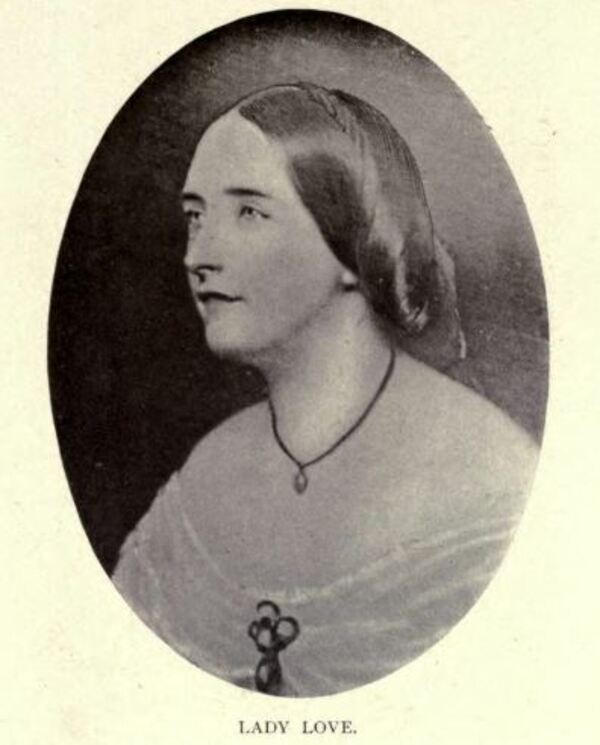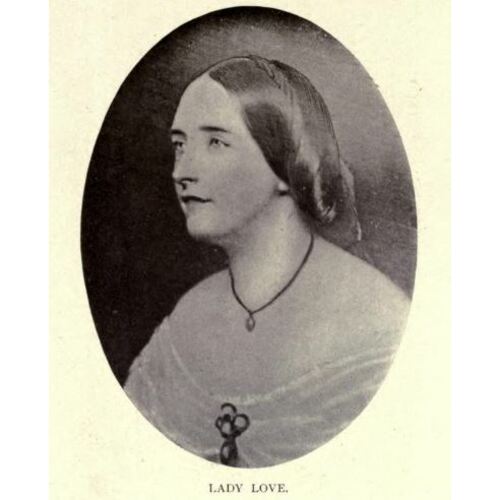
Source: Link
HEAVISIDE, MARY (Lady Love), artist and lithographer; baptized 25 June 1806 in Halifax, N.S., youngest daughter of Thomas Heaviside, a dry goods dealer and later a prosperous lumber merchant, and his wife Elizabeth; fl. 1806–66.
Mary Heaviside was educated in England where she also studied art. On 16 July 1825 she married Lieutenant-Colonel James Frederick Love, who had entered the 52nd Light Infantry in 1804, had fought in the Napoleonic wars at La Coruña and at Waterloo under Sir John Colborne, and had come out to New Brunswick as an inspecting field officer of militia. He was stationed in the years 1825–30 at Saint John and St Andrews.
In this period Mary Love apparently developed both her interest and her skill in drawing. In 1830 she executed at least two sketches which were signed “Drawn on stone by M. Love” and lithographed by John B. Pendleton of Boston, Mass., whose firm, established in 1826, had first produced lithographs commercially in the United States. Entitled “A view near St. Andrews, New Brunswick (Chamcook)” and “A view on the St. Croix River, New Brunswick,” Mary Love’s two lithographs have been described by a modern art historian in the 1960 New Brunswick Museum Art Bulletin as probably the first lithographs drawn on stone in Canada by a Canadian-born artist. The sketches, charming and sensitively delineated scenes, compare favourably with the work of other artists of the early 19th century.
The Bulletin suggests that Pendleton would likely have published a set of at least four sketches, and that the two illustrations used by Joseph Bouchette* in The British dominions in North America . . . (2v., London, 1832), which were signed “By a Lady,” were Mary Love’s work. These, “New Government House, Fredericton, N.B.” and “Barracks and Market Square, Fredericton, N. B.,” seem to be drawn in the same style as Mrs Love’s known sketches. Another unsigned plate in Bouchette’s book, “On the Kennebeckasis near St. John,” seems attributable to her as well.
The illustrations “by a Lady” in a book of poetry entitled A peep at the Esquimaux . . . , published in London in 1825, have sometimes been attributed to Mrs Love. The drawings were largely based on illustrations by Captain G. F. Lyon in the journal of an Arctic voyage by W. E. Parry* published the year before. Conjectures about the identity of the “Lady” who was their author are unsupported by convincing evidence.
After postings in Great Britain and the Mediterranean Lieutenant-Colonel Love was back in British North America in 1838, when he commanded a column during the rebellion in Lower Canada. He was subsequently commander on the Sarnia frontier from 1838 to 1840. Mary Love, it seems, continued her work as an artist, since H. J. Morgan* quotes a newspaper of the period which stated that she had made finely executed water-colour sketches of the Eastern Townships and other parts of Lower Canada, and expressed the wish that “the fair artist may consent to their being published, when Mrs. Love’s taste and genius will be made as manifest to the world as her kindly and graceful manners have been appreciated, wherever she has resided in Canada.”
Mary Love’s husband was in England once more early in the 1840s. He held various military posts including that of governor of Jersey (1852–56) and was knighted in 1856. Lady Love was in London with him at the time of his death on 13 Jan. 1866. She had no children. Efforts to trace her later life and determine the date of her death through descendants of her sisters Ann Maria, the wife of Archdeacon Robert Willis of Halifax, and Jane, the wife of Alexander Wedderburn* of Saint John, have yielded no further information.
The author would like to thank Donald C. Mackay for providing valuable information. St Paul’s Anglican Church (Halifax), register of baptisms, 1791–1816 (mfm. at PANS). Arthur papers (Sanderson), I, 441–42; II, 219–21, 318, 401; III, 54–55, 64–65, 104. Gentleman’s Magazine, CCXX, (January–June 1866), 442. Boase, Modern English biog. (1965), II, 562. DNB. Harper, Early painters and engravers. Types of Canadian women and of women who have been connected with Canada, ed. H. J. Morgan (Toronto, 1903). N.B. Museum, Art Bull., ([Saint John]), V, no.1 (September 1960), [10–12]. Judith St John, “A peep at the Esquimaux through early children’s books,” Beaver, outfit 296 (winter 1965), 38–44. Ottawa Citizen, 11 Feb. 1963.
Cite This Article
Phyllis Creighton, “HEAVISIDE, MARY (Love) (Lady Love),” in Dictionary of Canadian Biography, vol. 9, University of Toronto/Université Laval, 2003–, accessed January 2, 2026, https://www.biographi.ca/en/bio/heaviside_mary_9E.html.
The citation above shows the format for footnotes and endnotes according to the Chicago manual of style (16th edition). Information to be used in other citation formats:
| Permalink: | https://www.biographi.ca/en/bio/heaviside_mary_9E.html |
| Author of Article: | Phyllis Creighton |
| Title of Article: | HEAVISIDE, MARY (Love) (Lady Love) |
| Publication Name: | Dictionary of Canadian Biography, vol. 9 |
| Publisher: | University of Toronto/Université Laval |
| Year of publication: | 1976 |
| Year of revision: | 1976 |
| Access Date: | January 2, 2026 |



